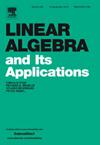Doubly transitive equiangular tight frames that contain regular simplices
IF 1.1
3区 数学
Q1 MATHEMATICS
引用次数: 0
Abstract
An equiangular tight frame (ETF) is a finite sequence of equal norm vectors in a Hilbert space that achieves equality in the Welch bound, and so has minimal coherence. The binder of an ETF is the set of all subsets of its indices whose corresponding vectors form a regular simplex. An ETF achieves equality in Donoho and Elad's spark bound if and only if its binder is nonempty. When this occurs, its binder is the set of all linearly dependent subsets of it of minimal size. Moreover, if members of the binder form a balanced incomplete block design (BIBD) then its incidence matrix can be phased to produce a sparse representation of its dual (Naimark complement). A few infinite families of ETFs are known to have this remarkable property. In this paper, we relate this property to the recently introduced concept of a doubly transitive equiangular tight frame (DTETF), namely an ETF for which the natural action of its symmetry group is doubly transitive. In particular, we show that the binder of any DTETF is either empty or forms a BIBD, and moreover that when the latter occurs, any member of the binder of its dual is an oval of this BIBD. We then apply this general theory to certain known infinite families of DTETFs. Specifically, any symplectic form on a finite vector space yields a DTETF, and we compute the binder of it and its dual, showing that the former is empty except in a single notable case, and that the latter consists of affine Lagrangian subspaces. This unifies and generalizes several results from the existing literature. We then consider the binders of four infinite families of DTETFs that arise from quadratic forms over the field of two elements, showing that two of these are empty except in a finite number of cases, whereas the other two form BIBDs that relate to each other, and to Lagrangian subspaces, in nonobvious ways.
包含正则单形的双传递等角紧框架
等角紧框架(ETF)是Hilbert空间中相等范数向量的有限序列,在Welch界内达到相等,因此具有最小相干性。ETF的绑定器是其指数的所有子集的集合,其对应的向量构成正则单纯形。当且仅当绑定器非空时,ETF在多诺霍和埃拉德的火花绑定中实现相等。当这种情况发生时,它的绑定是它的所有最小大小的线性相关子集的集合。此外,如果结合部的成员形成一个平衡的不完全块设计(BIBD),那么它的关联矩阵可以分阶段产生其对偶(Naimark补)的稀疏表示。已知有几个无限的etf家族具有这种显著的特性。在本文中,我们将这一性质与最近引入的双传递等角紧框架(DTETF)的概念联系起来,即对称群的自然作用是双传递的ETF。特别地,我们证明了任何DTETF的粘结剂要么是空的,要么形成一个BIBD,而且当后者发生时,它的对偶的粘结剂的任何成员都是这个BIBD的一个椭圆。然后,我们将这一一般理论应用于某些已知的无限dtetf族。具体地说,有限向量空间上的任何辛形式都会产生一个DTETF,我们计算了它和它的对偶的结合部,证明了前者除了在一个明显的情况下是空的,而后者由仿射拉格朗日子空间组成。这统一和概括了现有文献的几个结果。然后,我们考虑由两个元素域上的二次形式产生的四个无限dtetf族的结合部,表明其中两个族除了在有限的情况下是空的,而另外两个形成的bibd以不明显的方式相互关联,并与拉格朗日子空间相关。
本文章由计算机程序翻译,如有差异,请以英文原文为准。
求助全文
约1分钟内获得全文
求助全文
来源期刊
CiteScore
2.20
自引率
9.10%
发文量
333
审稿时长
13.8 months
期刊介绍:
Linear Algebra and its Applications publishes articles that contribute new information or new insights to matrix theory and finite dimensional linear algebra in their algebraic, arithmetic, combinatorial, geometric, or numerical aspects. It also publishes articles that give significant applications of matrix theory or linear algebra to other branches of mathematics and to other sciences. Articles that provide new information or perspectives on the historical development of matrix theory and linear algebra are also welcome. Expository articles which can serve as an introduction to a subject for workers in related areas and which bring one to the frontiers of research are encouraged. Reviews of books are published occasionally as are conference reports that provide an historical record of major meetings on matrix theory and linear algebra.

 求助内容:
求助内容: 应助结果提醒方式:
应助结果提醒方式:


